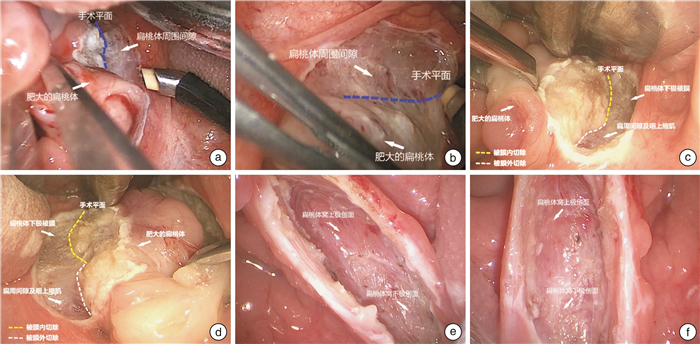Application of combined intracapsular and extracapsular hypothermic plasma tonsillectomy in reducing intraoperative and postoperative hemorrhage in children with OSA
-
摘要: 目的 探讨联合被膜内外低温等离子扁桃体切除术在减少儿童OSA术中和术后出血中的应用及优势。方法 回顾分析726例儿童OSA临床资料,根据手术方式分为常规低温等离子扁桃体全切除术组(320例)和联合被膜内外低温等离子扁桃体切除术组(406例),比较2组患儿术中出血量、术后出血时间、出血部位及出血程度。结果 2组患儿术中出血量无显著差异[(9.3±4.6) mL vs(7.6±3.5) mL,t=12.687,P=0.235)];联合被膜内外低温等离子扁桃体切除术组共2例患儿出现术后出血,总术后出血率较低温等离子扁桃体全切除术组(14例)明显减低(χ2=10.779,P=0.001);联合被膜内外低温等离子扁桃体切除术组2例术后出血均为继发性出血,出血部位分别为扁桃体窝上极和中部,出血程度均为A级;低温等离子扁桃体全切除术组14例术后出血中原发性出血2例,继发性出血12例,出血部位为扁桃体窝上极1例,中部2例,下极11例;出血程度为A级出血5例,B级出血8例,C级出血1例;联合被膜内外低温等离子扁桃体切除术组术后7 d以上出血率(χ2=5.697,P=0.017)、扁桃体下极出血率(χ2=11.961,P=0.001)、B级出血率(χ2=8.097,P=0.004)均较低温等离子扁桃体全切除术组明显减低。结论 联合被膜内外低温等离子扁桃体切除术是一种安全、有效的手术方法,在减少低温等离子扁桃体术后出血,尤其是扁桃体下极继发性出血方面具有明显优势。
-
关键词:
- 睡眠呼吸暂停, 阻塞性 /
- 等离子 /
- 扁桃体切除术 /
- 手术后出血 /
- 儿童
Abstract: Objective The aim of this study is to explore the application and advantages of combined intrathecal and extrathecal hypothermic plasma tonsillectomy in reducing intraoperative and postoperative hemorrhage in OSA children.Method We retrospectively reviewed 726 cases who were diagnosed as OSA. All patients were divided into two groups according to the surgical method: 320 cases by total tonsillectomy and 406 cases by combined extracapsular and intracapsular tonsillectomy. The intro operative bleeding volume, post operative haemorrhage data as time, location and degree in the two groups were compared.Result There was no statistical difference in the intro operative bleeding volume in the two groups [(9.3±4.6) mL]vs [(7.6±3.5) mL], t=12.687, P=0.235. Two patients who underwent combined extracapsular and intracapsular tonsillectomy presented with post operative haemorrhage, the total post operative haemorrhage rate was significantly decreased that in the total tonsillectomy group(14 cases)(χ2=10.779, P=0.001). The 2 patients in combined extracapsular and intracapsular tonsillectomy group were secondary haemorrhage, with location in the upper pole and medium, grade A haemorrhage; while in the 14 cases in in the total tonsillectomy group, there were 2 cases presented with primary haemorrhage and 12 cases with secondary haemorrhage; with regard to location of haemorrhage, 1 in the upper pole, 2 in the medium, 11 in the lower pole; 5 cases presented with grade A haemorrhage, 8 with grade B haemorrhage and 1 with grade C haemorrhage. The haemorrhage rate at 7 days after surgery (χ2=5.697, P=0.017), at the lower pole(χ2=11.961, P=0.001) and grade B(χ2=8.097, P=0.004) were all significantly decreases in the combined extracapsular and intracapsular tonsillectomy group.Conclusion Plasma tonsillectomy combined with intrathecal and extrathecal hypothermic tonsillectomy is a safe and effective method, which has obvious advantages in reducing the postoperative hemorrhage, especially the secondary hemorrhage of Subtonsillar Pole.-
Key words:
- sleep apnea /
- coblation /
- tonsillectomy /
- postoperative haemorrhage /
- child
-

-
表 1 2组患儿临床资料比较
x±s 组别 例数 性别 年龄/岁 AHI 合并慢性扁桃体炎 合并腺样体肥大 男 女 是 否 是 否 A组 320 173 147 5.1±2.8 9.6±3.1 109 211 263 57 B组 406 222 184 5.9±2.1 8.3±2.5 158 248 321 85 χ2/t 0.008 8.126 15.238 1.610 0.920 P 0.928 0.429 0.263 0.204 0.337 表 2 2种不同手术方式术后出血情况比较
A组(n=320) B组(n=406) χ2 P 出血时间 术后24 h 2(0.63) 0(0) 0.778 0.378 术后1~3 d 0(0) 0(0) - - 术后4~6 d 4(1.25) 1(0.25) 1.373 0.241 术后7 d以上 8(2.50) 1(0.25) 5.697 0.017 出血部位 上极 1(0.31) 1(0.25) 0.296 0.586 中部 2(0.63) 1(0.25) 0.429 0.836 下极 11(3.44) 0(0) 11.961 0.001 出血程度 A级 5(1.56) 2(0.49) 1.171 0.279 B级 8(2.50) 0(0) 8.097 0.004 C级 1(0.31) 0(0) 0.296 0.586 D级 0(0) 0(0) - - E级 0(0) 0(0) - - 合计 14(4.38) 2(0.49) 10.779 0.001 -
[1] 陈雄, 肖英, 何烈纯, 等. 低温等离子辅助悬雍垂腭咽成形术与常规手术并发症的比较[J]. 中华耳鼻咽喉头颈外科杂志, 2012, 47(2): 101-106. doi: 10.3760/cma.j.issn.1673-0860.2012.02.004
[2] 刘大波, 谭宗瑜, 钟建文, 等. 儿童扁桃体腺样体低温等离子手术迟发性出血的初步研究[J]. 中华耳鼻咽喉头颈外科杂志, 2010, 45(5): 373-376. doi: 10.3760/cma.j.issn.1673-0860.2010.05.006
[3] Söderman AC, Odhagen E, Ericsson E, et al. Post-tonsillectomy haemorrhage rate are related to technique for dissection and for haemostasis. An analysis of 15734 patients in the National Tonsil Surgery Register in Sweden[J]. Clin Otolaryngol, 2015, 40(3): 248-254. doi: 10.1111/coa.12361
[4] 张庆丰, 佘翠萍, 李大伟, 等. 低温等离子射频扁桃体部分切除术治疗儿童阻塞性睡眠呼吸暂停低通气综合征[J]. 临床耳鼻咽喉头颈外科杂志, 2011, 25(3): 114-116. https://www.cnki.com.cn/Article/CJFDTOTAL-LCEH201103008.htm
[5] 中华耳鼻咽喉头颈外科杂志编委会. 儿童阻塞性睡眠呼吸暂停低通气综合征诊疗指南草案(乌鲁木齐)[J]. 中华耳鼻咽喉头颈外科杂志, 2007, 42(2): 83-84. doi: 10.3760/j.issn:1673-0860.2007.02.002
[6] Sarny S, Ossimitz G, Habermann W, et al. Hemorrhage following tonsil surgery: a multicenter prospective study[J]. Laryngoscope, 2011, 121(12): 2553-2560. doi: 10.1002/lary.22347
[7] 王钧, 陈洁, 杨军, 等. 低温等离子射频消融手术治疗儿童OSAHS术后出血原因分析及处理[J]. 临床耳鼻咽喉头颈外科杂志, 2013, 27(18): 1003-1005. https://www.cnki.com.cn/Article/CJFDTOTAL-LCEH201318008.htm
[8] 叶钰华, 王智楠, 徐忠强, 等. 儿童低温等离子扁桃体切除术后迟发性出血的原因分析[J]. 临床耳鼻咽喉头颈外科杂志, 2015, 29(6): 528-531. https://www.cnki.com.cn/Article/CJFDTOTAL-LCEH201506013.htm
[9] Söderman AC, Odhagen E, Ericsson E, et al. The effect of perioperative dexamethasone dosing on post-tonsillectomy hemorrhage risk[J]. Int J Pediatr Otorhinolaryngol, 2017, 98: 19-24. doi: 10.1016/j.ijporl.2017.04.033
[10] 李大伟, 张庆丰, 张欣然. 低温等离子射频扁桃体部分切除术及全切术治疗儿童OSAHS的疗效比较[J]. 临床耳鼻咽喉头颈外科杂志, 2013, 27(6): 281-283. https://www.cnki.com.cn/Article/CJFDTOTAL-LCEH201306000.htm
[11] Divi V, Benninger M. Postoperative tonsillectomy bleed: coblation versus noncoblation[J]. Laryngoscope, 2005, 115(1): 31-33. doi: 10.1097/01.mlg.0000150682.62517.0e
[12] Sorin A, Bent JP, April MM, et al. Complications of microdebrider-assisted powered intracapsular tonsillectomy and adenoidectomy[J]. Laryngoscope, 2004, 114(2): 297-300. doi: 10.1097/00005537-200402000-00022
[13] Solares CA, Koempel JA, Hirose K, et al. Safety and efficacy of powered intracapsular tonsillectomy in children: a multi-centerretrospective case series[J]. Int J Pediatr Otorhinolaryngol, 2005, 69(1): 21-26. doi: 10.1016/j.ijporl.2004.07.006
[14] 倪新生, 李力. 扁桃体被膜结构与临床的关系[J]. 山东医药, 2005, 45(21): 60-60. doi: 10.3969/j.issn.1002-266X.2005.21.047
[15] Isaacson G, Parikh T. Developmental anatomy of the tonsil and its implications for intracapsular tonsillectomy[J]. Int J Pediatr Otorhinolaryngol, 2008, 72(1): 89-96. doi: 10.1016/j.ijporl.2007.09.021
[16] Lee KD, Lee HS, Hong JC, et al. Diameter of vessels across the tonsillar capsule as an anatomical consideration for tonsillectomy[J]. Clin Anat, 2008, 21(1): 33-37. doi: 10.1002/ca.20562
[17] Farmer SE, Khatwa MA, Zeitoun HM. Peritonsillar abscess after tonsillectomy: a review of the literature[J]. Ann R Coll Surg Engl, 2011, 93(5): 353-355. doi: 10.1308/003588411X579793
-





 下载:
下载: